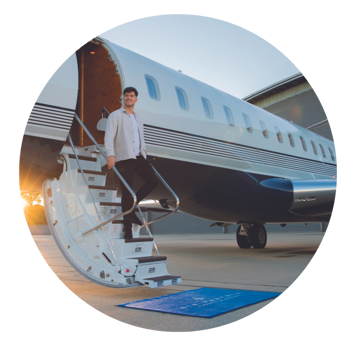Although the effects of jet lag are usually short-lived, the irregular and interrupted sleep patterns, feeling of exhaustion, and difficulty maintaining your usual focus are, nevertheless, disruptive and deeply unpleasant. Thankfully, traveling by private jet lag and preparing in advance can mitigate the severity of jet lag and speed up recovery. The Air Partner team, including our colleagues from aviation safety consultants Baines Simmons and luxury catering partner Bon Soirée, have compiled their top tips for before, during, and after your flight to help make debilitating jet lag a thing of the past.
What is jet lag?
Jet lag occurs when you cross multiple time zones, causing your body clock, or circadian rhythms, to fall out of sync with local time at your destination.
Every cell in our body has its own internal rhythm, and they adapt at different speeds following cross-timezone travel – one of the reasons we feel so out of sorts. Our rhythms have a genetic foundation but are very impacted by light, with other behaviors (such as meal timing) also influencing their timing. Because jet lag is caused by being out of sync, the greater the number of time zones crossed, the worse the jet lag will be. A rough rule of thumb is that it takes our body clock around one day to adjust to every time zone crossed (slightly longer if we have traveled to the east).
Many find that it’s easier to delay sleep and wake later than it is to fall asleep early and wake early. Therefore, it’s also useful to appreciate and plan accordingly that eastbound travel can cause more intense symptoms and require a longer recovery period than traveling westbound.
Evidence also suggests that individuals who prefer later sleep times cope better with jet lag than 'morning types.' This is because 'evening types' have been shown to adapt more easily to new schedules.
The other challenge for a long travel is so-called ‘travel fatigue.’ Whether we are crossing time zones or not, long flights can leave us feeling very tired. This can be due to spending time in a cramped environment, with limited movement and poor sleep, and we are often dehydrated too. This ‘travel fatigue’ usually resolves after one or two good nights of sleep at your destination.
How to avoid jet lag and travel fatigue
In Advance: Pre-flight Prep
- Making subtle changes to your sleep pattern before traveling can help to prepare your body clock. If you’re traveling east, try moving your bedtime and waking time forward by one hour per day in the few days leading up to departure. Or, if you’re traveling west, move your bedtime and waking time one hour later each night. To increase the effectiveness of this, move your meal times according to the same pattern.

- Select your flight timing carefully – flights associated with the least amount of time between sleep opportunities (for instance, the time between waking at home to the time going to bed in the evening at your destination) seem to help with quicker adaptation.
- Avoid burning the candle at both ends – if you’re tired before you set off, it will only accentuate the effects of jet lag and travel fatigue, so it’s important, whenever possible, to feel rested before undertaking your journey.
- Make sure you’re well hydrated before stepping onto the aircraft. Drink plenty of water or carbonated low-caffeine drinks, and, for best results, limit your intake of coffee and alcohol, as they will disrupt your sleep on board.
- Plan in advance - Ideally, leave yourself a day or so on arrival to adjust and recover from travel fatigue before important meetings or events and alleviate any stresses by pre-planning your itinerary for the first few days.
In the Air: Getting You Adjusted
- When you board your flight, set watches and phones to the local time at your destination and help your body adjust by taking your meals and periods of sleep to fit with the new time zone.

- Ideal menus and meal times can be planned in advance with your dedicated Account Manager. Thanks to our private aviation dining partner, Bon Soirée, you can enjoy an unparalleled in-flight dining experience. Menus are curated to not only taste exceptional at altitude but a focus on fresh, nutritious ingredients that are easily digestible and help to avoid any discomfort. These can be timed to match the ‘right’ meal at your destination – evidence shows meal timing is another key jet lag adaptation strategy.
- Light exposure, from sunlight or bright artificial light, is one of the most significant factors in governing both sleep and the body clock. Take advantage of the high-tech lighting systems onboard Air Partner flights, something not found on commercial aircraft, and have the cabin light levels and tones adjusted to your needs, including being able to sleep in complete darkness.
- As you prepare for sleep, avoid phones or laptop screens and ideally set your devices to night settings to eliminate ‘blue light’ that will hamper your efforts to fall asleep.
- While awake, move around the cabin and take the opportunity to stretch or engage in some gentle exercise. This will help to prevent tension build-up and reduce the risk of muscle stiffness, both of which can make it harder to sleep and cause post-flight travel fatigue. It’s also essential you maintain hydration, with water or fruit juices being the best in-flight choices.
On Arrival: Rapid Recovery
- You’ll most likely feel tired, but try to avoid sleeping during the day. However, if necessary, taking a refreshing 20-minute power nap before resuming the local time routine won’t do any harm.

- Even if it’s a gentle workout, exercise is a great way to naturally alleviate the feelings of jet lag and realign your body clock. If you travel west to east, exercise in the early morning or early to mid-afternoon, whereas for those traveling east to west, it's best to exercise in the evening. However, whenever you do it, a workout is always a great way to speed up your adjustment time.
- Exposure to bright light, particularly daylight, is a major influencing factor on your circadian rhythm and can be used to help align your body clock. However, we have to time it right to benefit and not accidentally delay our adaptation:
- After eastbound travel, aim to get light exposure between mid-morning and mid-afternoon in your new time zone. The more timezones that you cross, the later this ‘timeband’ moves (e.g., if you cross four timezones, the best time to seek light is between 0900-1500 local time. Move this one hour later for every additional timezone)
- After westbound travel, it is better to seek light later in the day to support staying awake. If traveling four timezones west, the best time to seek light is between 1700-2300 local time – for every extra timezone, move this window earlier by one hour.
Arrive On Time, Refreshed and Stress-Free with Air Partner
As well as their luxurious surroundings and high standards, private jets have many additional benefits that make them the perfect partner for those looking to reduce jet lag. From the ideal altitude and cabin pressure, which makes you far less prone to fatigue or jet lag than on a commercial flight, to the flexible scheduling, custom lighting, and bespoke meal plans and timing, arriving with Air Partner will help to ensure you are refreshed, relaxed, and ready to go.



